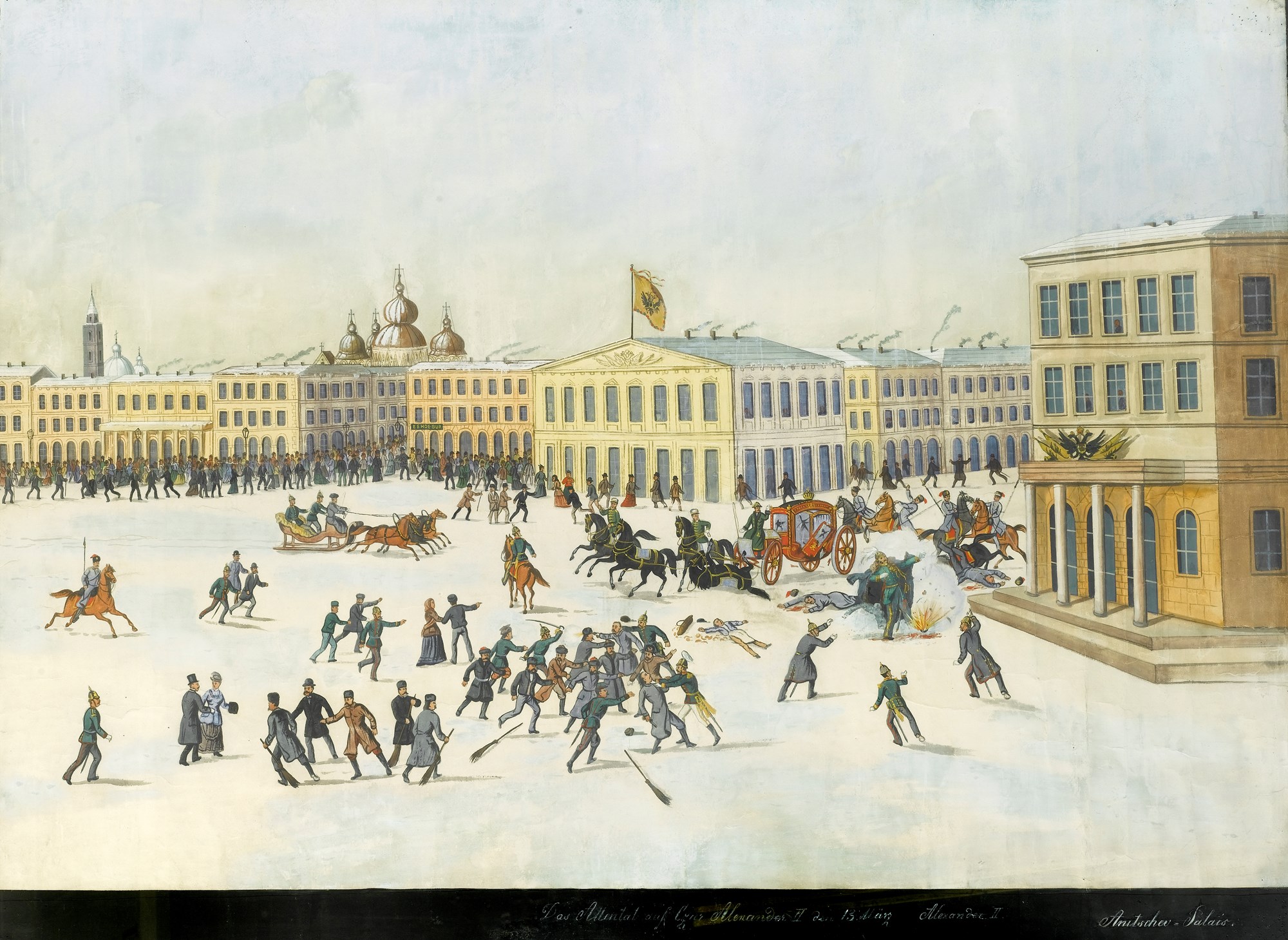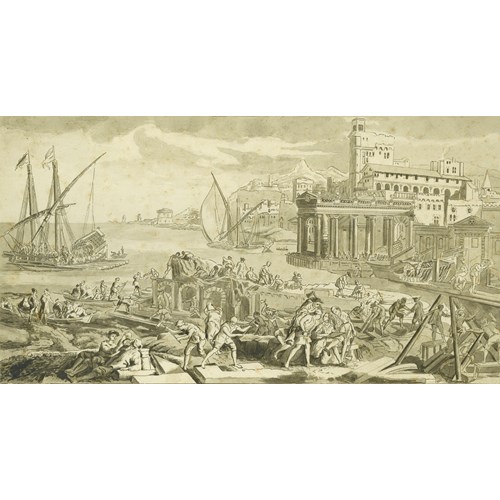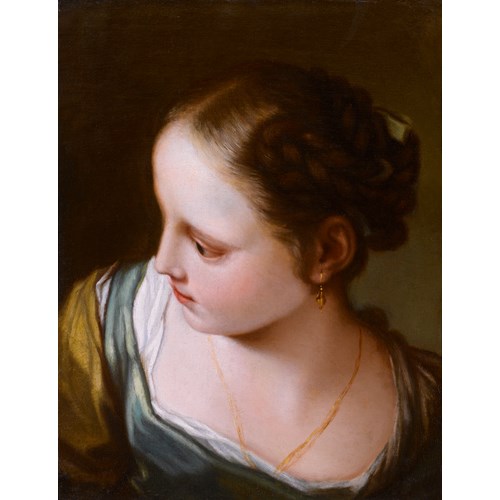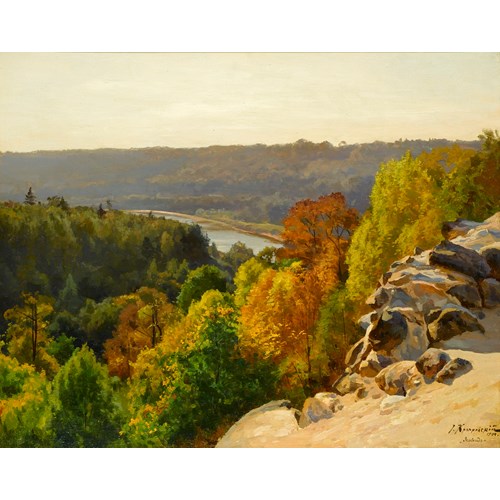Marketplace
The Assassination of Alexander II
School Russian
The Assassination of Alexander II
Date after 1881
Epoque 1850-1900, 19th century
Origine Russia
Medium Gouache on paper
Dimension 101.5 x 135 cm (40 x 53¹/₈ inches)
This simple yet refined picture from the Russian School documents one of the most important events in Russian history. The nineteenth century was a time of great change and development which led to the establishment of a truly Russian school of art. Russian artists took a renewed interest in the world surrounding them and departed from their previous admiration for European countries such as France and Italy. A new emphasis was placed on individual portraiture, and historical events were rehabilitated in art as a valuable means of preserving Russian heritage and identity.
Here we see the assassination of Tsar Alexander II (1818-1881), the culmination of many previous attempts and an event which led to unimaginable consequences for the Russian people. The picture displays no elaborate sentimentality of the event but simply allows the viewer an objective snapshot of the scene.
Set against a backdrop of governmental buildings, the scene joins the assassination at its climax, amid a mêlée of frantic commotion. The Tsar, as he was known to do every Sunday, went to the Manezh to review the regiment of the Life Guards. He travelled in a closed carriage accompanied by several Cossack guards. As we see in the background of the picture the streets were flanked by sidewalks full of people. It was here that a young member of the revolutionary movement Narodnova Volya (‘People’s Will’), Nikolai Rysakov (1861-1881), detonated a first bomb. The explosion killed one of the Cossacks and wounded the driver.
To the right of the centre, we see that the Tsar’s bulletproof carriage, a gift from Napoleon III (1808-1873), had only been damaged by the explosion. However, as a result the horses are rearing frantically and one has fallen to the snow-covered ground. The Tsar had emerged from this unscathed, but the surrounding guards and Cossacks eager for him to leave the area, rush to his aid in the sleighs accompanying his carriage. To the right of the carriage we see the discharge of a second bomb at the feet of Alexander II. This was the work of a second young member of the Narodnova Volya, Ignacy Hryniewiecki (1856-1881), who stood before the Tsar, raised his arms and threw the bomb at the Tsar’s feet. The result this time was catastrophic: his legs were shattered and he was mortally wounded. Alexander II was carried by sleigh to the Winter Place, where on 1st March 1881 at 3:30 pm, his standard was lowered for the last time.
After assuming power in 1855 in the wake of Russia’s disastrous defeat in the Crimean war against Britain, France and Turkey, Alexander II initiated a number of reforms. In 1861 he freed the Russian serfs - peasants, who were virtually enslaved to their owners - from their ties to their masters and undertook a rigorous programme of military, judicial and urban reforms never before attempted in Russia. Alexander’s reforms did not, however, satisfy liberals and radicals, who wanted a parliamentary democracy and the same freedom of expression that was enjoyed in the United States of America and most European nations. The reforms in agriculture also disappointed the peasants. In some regions it took peasants nearly twenty years to obtain their land. Many were forced to pay more than the land was worth and others were given inadequate amounts for their needs.
This was the seventh and final assassination attempt by members of the Narodnova Volya. Rather than achieving the revolution and reform they desired, the assassination of Alexander II brought to the throne his reactionary son, Alexander III (1845-1894) under whose autocratic leadership all ambitions of the revolutionary group were ruthlessly eliminated. The buildings that bore witness to the assassination have long since disappeared. In their place stands a magnificent and opulent memorial, The Church of Our Saviour on Spilled Blood.
Although the present work was painted after 1881, stylistically it follows in the tradition of artists working in Russia such as Johann Georg Mayr (1760-1816), or more contemporarily, Prince Grigory Grigorievich Gagarin (1811-1893). Although it has a much calmer mood, Gagarin’s watercolour Alexander Column in Scaffolding, takes a similar panoramic viewpoint across a wide, open, urban landscape. This compositional device ensures that there are a multitude of figurative details to divert the viewer, and in both works they are painted in the same, slightly elongated style. So although The Assassination of Alexander II depicts what was a recent event, it harks back to earlier generations of Russian urban landscape painting.
Here we see the assassination of Tsar Alexander II (1818-1881), the culmination of many previous attempts and an event which led to unimaginable consequences for the Russian people. The picture displays no elaborate sentimentality of the event but simply allows the viewer an objective snapshot of the scene.
Set against a backdrop of governmental buildings, the scene joins the assassination at its climax, amid a mêlée of frantic commotion. The Tsar, as he was known to do every Sunday, went to the Manezh to review the regiment of the Life Guards. He travelled in a closed carriage accompanied by several Cossack guards. As we see in the background of the picture the streets were flanked by sidewalks full of people. It was here that a young member of the revolutionary movement Narodnova Volya (‘People’s Will’), Nikolai Rysakov (1861-1881), detonated a first bomb. The explosion killed one of the Cossacks and wounded the driver.
To the right of the centre, we see that the Tsar’s bulletproof carriage, a gift from Napoleon III (1808-1873), had only been damaged by the explosion. However, as a result the horses are rearing frantically and one has fallen to the snow-covered ground. The Tsar had emerged from this unscathed, but the surrounding guards and Cossacks eager for him to leave the area, rush to his aid in the sleighs accompanying his carriage. To the right of the carriage we see the discharge of a second bomb at the feet of Alexander II. This was the work of a second young member of the Narodnova Volya, Ignacy Hryniewiecki (1856-1881), who stood before the Tsar, raised his arms and threw the bomb at the Tsar’s feet. The result this time was catastrophic: his legs were shattered and he was mortally wounded. Alexander II was carried by sleigh to the Winter Place, where on 1st March 1881 at 3:30 pm, his standard was lowered for the last time.
After assuming power in 1855 in the wake of Russia’s disastrous defeat in the Crimean war against Britain, France and Turkey, Alexander II initiated a number of reforms. In 1861 he freed the Russian serfs - peasants, who were virtually enslaved to their owners - from their ties to their masters and undertook a rigorous programme of military, judicial and urban reforms never before attempted in Russia. Alexander’s reforms did not, however, satisfy liberals and radicals, who wanted a parliamentary democracy and the same freedom of expression that was enjoyed in the United States of America and most European nations. The reforms in agriculture also disappointed the peasants. In some regions it took peasants nearly twenty years to obtain their land. Many were forced to pay more than the land was worth and others were given inadequate amounts for their needs.
This was the seventh and final assassination attempt by members of the Narodnova Volya. Rather than achieving the revolution and reform they desired, the assassination of Alexander II brought to the throne his reactionary son, Alexander III (1845-1894) under whose autocratic leadership all ambitions of the revolutionary group were ruthlessly eliminated. The buildings that bore witness to the assassination have long since disappeared. In their place stands a magnificent and opulent memorial, The Church of Our Saviour on Spilled Blood.
Although the present work was painted after 1881, stylistically it follows in the tradition of artists working in Russia such as Johann Georg Mayr (1760-1816), or more contemporarily, Prince Grigory Grigorievich Gagarin (1811-1893). Although it has a much calmer mood, Gagarin’s watercolour Alexander Column in Scaffolding, takes a similar panoramic viewpoint across a wide, open, urban landscape. This compositional device ensures that there are a multitude of figurative details to divert the viewer, and in both works they are painted in the same, slightly elongated style. So although The Assassination of Alexander II depicts what was a recent event, it harks back to earlier generations of Russian urban landscape painting.
Date: after 1881
Epoque: 1850-1900, 19th century
Origine: Russia
Medium: Gouache on paper
Dimension: 101.5 x 135 cm (40 x 53¹/₈ inches)
Plus d'œuvres d'art de la Galerie









